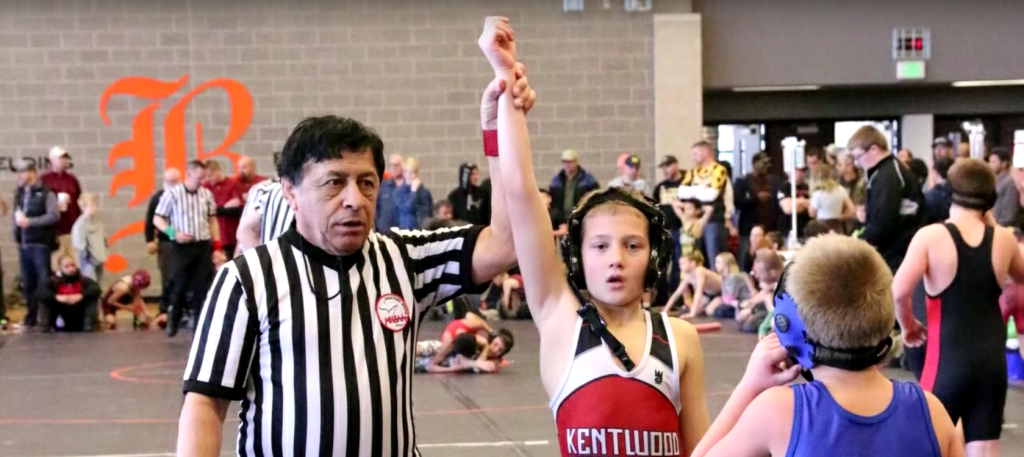I recently had the chance to put this adage to the test. My eldest son Peter was given an assignment at school to create a documentary about someone in his family, and he asked me to assist him. He chose to focus on my middle son, Stellan, who has had a fair amount of success as a young wrestler. We started by interviewing people important to the story – Stellan, his mother and me, his coach, and his teammate – using a semi-professional camera and equipment that totaled around $3500. The same package was used to capture footage of Stellan’s practice session. When Peter and I had the interviews whittled down and a script recorded, we began filling in the video with footage captured over several years on many different cameras, including a top-of-the-line camcorder, a GoPro Hero 3, three different cell phones, and a little waterproof Kodak video camera that I got on clearance for $25. While each camera had its own characteristic look, the video from all of them was more than adequate to tell the story. While I wouldn’t advocate using just any camera for professional work, I was surprised at how well the footage from all these different cameras cut together. I would argue that with attention to lighting, I could create a professional looking piece with any one of the cameras that were used.
So, if great-looking, professional quality video can be captured on just about any camera these days, why bother hiring a pro with an expensive camera package to shoot your video? Why not just put an iPhone on a selfie-stick and press record? The answer is, you CAN! But, there are other considerations aside from video quality that you should consider.
Lighting: Perhaps the biggest difference between amateur video and professional video is attention to lighting. Making sure the subject of the video is properly exposed is important, but so is paying attention to exactly what IS visible in the scene, and what isn’t or shouldn’t be. Lighting can be used to draw the eye toward the part of the scene you want to highlight or to distract from something else. The positioning and intensity of the light is important too. Flat, even lighting tends to be perceived as boring or cheap. Lighting that is too dramatic or harsh can be distracting or even create an ominous mood that could be detrimental to your message. A good professional knows how to use lighting to craft the message you want to send.
Audio Quality: It is often said that viewers will forgive a bad picture, but not bad sound. While improvements have been made to onboard microphones over the years, the best sound is still captured with an external microphone. Of these, the most practical to use on most video productions are lavalier microphones, which are placed on the subject, and shotgun microphones, which are mounted on the camera or on a boom. Decent quality can be achieved from microphones costing as little as $30, but in general as the price increases, so does quality. It is important to place the mic near the subject. Contrary to popular belief, shotgun mics are not meant to pick up sound from a distance. They are meant to be placed within a few feet of the subject and aimed at the audio source. Again, a video professional knows this and often has an assortment of high-quality microphones at his or her disposal.
Composition and Lens Choice: As good as the video from a cell phone or action camera can be, the fact remains that these cameras are stuck with a single lens, and all tend to be very wide. This limitation can be overcome somewhat by moving closer or farther away from the subject, or by using (Gulp) digital zoom (just don’t). However, the choice of lens can affect the message as much as the way a scene is lit. As a society that has grown up viewing photographs and motion pictures, we have developed feelings and expectations centered around the way a shot is framed. We expect to see vistas and cityscapes captured with a wide angle lens with little distortion, while people tend to be captured with a normal or slightly telephoto portrait lens. Scenes that are shot too wide or too close can seem disinteresting, or worse, unsettling. Of course, there are times when you may want your project to appear different from what is normally expected, and the video pro knows how to make that happen too.
This opinion is not meant to discourage the reader from attempting to shoot his or her own video. As a creative professional who was able to turn a hobby into a career, I encourage everyone to tap into their creative sides, whether that is by shooting video, photography, painting, music, etc. Rather, I’d ask that you consider this: how important is the message you are trying to send, and what crowd are you trying to reach? Here I will leave you with the third and final adage of the day: Content is King. People are often willing to overlook poor video and sound if the content is interesting. This is how America’s Funniest Home Videos, Vine, and YouTube have thrived over the years. However, your business presentation is not likely to be as short or funny as this laughing baby, or this indignant child. The video professional can use his or her tools, talent, and experience to help you craft your message in new and exciting ways.
